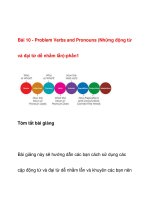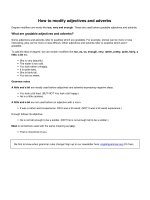Demonstrative adjectives and pronouns
Bạn đang xem bản rút gọn của tài liệu. Xem và tải ngay bản đầy đủ của tài liệu tại đây (137.63 KB, 15 trang )
Unit 20 (Unidad 20)
Demonstrative adjectives and
pronouns (Los adjetivos y
pronombres demostrativos)
Level 1
1.1 Demonstrative adjectives (Adjetivos demostrativos)
1.2 Demonstrative pronouns (Pronombres demostrativos)
1.3
´
Este and aqu ´el = the latter and the former
1.4 Neuter pronouns (Pronombres neutros)
1.1 Demonstrative adjectives
i There are three demonstrative adjectives in Spanish. They correspond to the English
this, these, that and those. They agree with the noun to which they relate, in the
same manner as adjectives:
m. f. neuter
este esta esto this
sing. ese esa eso that (near you)
aquel aquella aquello that (further away)
estos estas – these
plur. esos esas – those (near you)
aquellos aquellas – those (further away)
ii Este denotes what is close by, or associated with, the speaker. Ese relates to the thing
that is close to the person addressed and not far from the speaker or addressee.
Aquel is far or remote from both. They precede the nouns to which they belong.
However, they can follow the noun (see level 2.1).
Examples
este timbre (M)/sello que tengo aqu´ı this stamp I have here
Esta rec´amara (M)/habitaci´on est´a sucia This (bed)room is dirty
Estos sobres no tienen timbres (M)/sellos These envelopes don’t have stamps
Estas papas (M)/patatas est´an buenas These potatoes are nice
Ese coche all´ıesdemipap´a(M)/padre That car there is my father’s
Esa casa enfrente se vende That house opposite is for sale
Esos ´arboles est´an en flor Those trees are in blossom
183
ASTUDENT GRAMMAR OF SPANISH
Esas chicas viven muy cerca Those girls live close by
aquel parque al otro lado del pueblo that park on the other side of the town
aquella pel´ıcula que vamos a ver that movie we are going to see
aquellos barcos que salen hoy those boats that leave today
aquellas monta˜nas que escaladamos those mountains we climb
iii With reference to time, este refers logically to the present, ese to a period relatively
near, while aquel applies to a remote period:
en este momento at this moment
durante ese a˜no during that year
aquella ´epoca en que Cort´es... that period when Cortes . . .
1.2 Demonstrative pronouns
i
´
Este, ´esta, ´ese, ´esa, aqu ´el, aqu ´ella, etc., are often used in comparisons as in:
Este muchacho es m´as abusado (M)/listo que ´ese This boy is cleverer than that one
Estas novelas son m´as interesantes que aqu´ellas These novels are more interesting than those
ii As pronouns, the above forms may or may not have a written accent. There is no
strict rule on this feature. It is argued that accents on pronouns avoid ambiguity.
However, ambiguity is extremely rare. At the same time, the Spanish Academy
considers omission of the written accent permissible, but the Spanish newspaper El
Pa
´
ıs, for instance, does not allow this omission. Furthermore, careful writers do seem
to censure its absence. So, it seems wiser to use it.
Examples
´
Este (este coche) es m´as caro que aqu´el This one (this car) is more expensive than
that one
´
Ese es un autor de primera categor´ıa That is a first-class author
Aqu´ella es una ´epoca fabulosa That is a fabulous period
Prefiero aqu´ellas en el escaparate Iprefer those in the store window
1.3
´
Este and aqu
´
el = the latter and the former
A further difference between
´
este and its variants, and aqu
´
el and its variants is that
´
este, etc., has the value of the latter,while aqu
´
el has the value of the former:
Hay una lucha entre los aztecas y los There is a struggle between the Aztecs
espa˜noles.
´
Estos tienen ca˜nones en tanto aqu´ellos . . . and the Spaniards. The latter have cannons
while the former...
1.4 Neuter pronouns
The neuter pronoun forms, esto, eso and aquello are also used but only absolutely:
that is to say, they are never found associated with nouns. They do not refer to anything
specific, persons or things. They apply to statements and abstract ideas:
184
20 Demonstrative adjectives and pronouns
¿Lees esto? Do you read this?
Eso es That’s it
Eso me parece incre´ıble That seems incredible to me
Aquello del vecino que pierde . . . That business of the neighbor who loses...
¿Puedes solucionar aquello de tu padre? ¿Can you sort out your father’s trouble/
business?
Eso may be substituted for aquello in the last two examples.
Ejercicios
Level 1
i Change the definite article to the correct demonstrative adjective e.g. este, esta,
estos, estas (there may be more than one solution)
Example
Mi primo quiere comprar las corbatas de ante > Mi primo quiere comprar estas
corbatas de ante
a Compro los peri´odicos en el quiosco
b Manuel va a comprar las naranjas
c El hombre olvida los boletos (M)/billetes
d Los lentes (M) que hallo son de Jorge
e Las gafas que encuentro son de Juan
f Los j´ovenes juegan f´utbol (M)/alf´utbol
g Hay que recoger a Mar´ıa en la estaci´on
h Los aviones nuevos son muy c´omodos
i El viaje de Barcelona a Valencia es muy c´omodo
j Las fotos de Oaxaca son muy interesantes
ii Change the demonstrative adjectives este, etc., to ese, esa, esos, esas
Example
Ha recibido esta carta de su hermana > Ha recibido esa carta de su hermana
a Saqu´e estas fotos en M´alaga
b Estas naranjas son bastante caras
c ¿Pasa este tren por C´ordoba?
d Esta lecci´on es muy f´acil
e Me pregunto qu´ehay en este paquete
f Voyavenderle los relojes a este cliente
iii Complete the following with aqu ´el, aqu ´ella, etc., as in the example
No quieren estas manzanas, sino ( ) > ...sino aqu´ellas
a No quieren este chocolate, sino (
)
b No quiero estos sillones, sino (
)
c No prefiero este carro (M)/coche, sino (
)
d No me gusta esta alfombra, sino (
)
e No comprar´e este disco, sino (
)
f No prefiero estas macetas, sino (
)
185
ASTUDENT GRAMMAR OF SPANISH
iv Complete the following with ´este, ´esta, etc
Example
Aquella computadora (M)esm´as r´apida que (
) > ...que´esta
a Ese ordenador es m´as caro que (
)
b Aquella lavadora es m´as eficiente que (
)
c Aquel cami´on (M)esm´as lento que (
)
d Esos mapas son m´as detallados que (
)
e Aquellas flores no son tan bonitas como (
)
f Esos sillones son m´as c´omodos que (
)
v Paired activity
Objective –Touse the demonstrative adjective with a noun, and then to refer to the
noun with a demonstrative pronoun
Method –Aasks B if (s)he can use/see, etc., “este objeto” = “this object.”Bsays “No” but
that A can use, etc., “´ese/aqu´el ” = “that object,” or B can see “that object” = ´ese/aqu´el
Examples
PREGUNTA: ¿Puedo usar este libro?
RESPUESTA: No, pero puedes usar ´ese/aqu´el
PREGUNTA: ¿Entiendes a este autor?
RESPUESTA: No, pero entiendo a ´ese/aqu´el
PREGUNTA: ¿Necesitas estos papeles?
RESPUESTA: No, pero necesito ´esos/aqu´ellos
Use the following combinations of verbs + nouns, or invent your own (by
unit 20 you are doubtless able to do this):
abrir ventana, cerrar puerta, ver al chico, comprar flores, leer peri´odico, hacer cama,
lavar pantal´on, limpiar el carro, entender chiste, dibujar florero, leer libro, querer
caramelo
Level 2
2.1 Demonstrative adjectives after the noun (Adjetivos demostrativos que siguen
al nombre)
2.2 Uses of the pronoun el (Usos del pronombre el )
2.1 Demonstrative adjectives after the noun
The adjectival este, ese and aquel and their variants may come after the noun. In these
cases, they frequently, but not always, suggest a pejorative or ironic touch.
La carretera esa es muy peligrosa That road is very dangerous
El chico aquel nunca estudia That boy never studies
La lavadora esta funciona fatal, es un cacharro This washing machine is hopeless, it’s a
piece of junk
la taimada esa that sly so and so
186
20 Demonstrative adjectives and pronouns
2.2 Uses of the pronoun el
i El,inits several forms, when used as a pronoun, does not accompany a noun, but
serves to avoid the repetition of one; it is equivalent to the English that, those, the
one, the ones, referring to something already mentioned or understood:
Compr´emicomputadora (M)yla que tiene mi hija I bought my computer and the one my
daughter has / my daughter’s
Me gusta mi ordenador y el que compraste I like my computer and the one you bought
Romp´ılapluma (M)m´ıa y la de mi cuate (M)/
amigo
Ibroke my pen and that of my friend / my
friend’s
Son muy bonitas las plantas en el jard´ın y las de al
lado
The plants in the yard/garden and those at
the side are very attractive
ii When a relative pronoun follows, el, los, la, las are used instead of the personal
pronouns ´el, los, la and las:
El que habl´oayerescolombiano The one who spoke yesterday is Colombian
La que nos encontramos es muy rica The one we met is very rich
Los que murieron eran canadienses Those who died were Canadians
Las que te ayudaron son muy majas Those who helped you are very nice
iii But when the relative following is governed by a preposition, aqu ´el is more usual as
an antecedent than el, when referring to persons:
Aqu´ella a quien he dado el regalo... The person / She to whom I gave the
present...
Aqu´ellos con quienes discutiste . . . Those with whom you had an argument . . .
Exercises
Level 2
i Cambia ese, esa, etc., a el, la, etc. + noun + ese, esa, etc., como en el ejemplo
Esa carretera es muy ancha > La carretera esa es muy ancha
a Esos libros son muy pesados
b Esta cocina est´amuy sucia
c Ese ordenador no funciona bien
d Estas sillas est´an casi todas rotas
e ¿Qu´evas a hacer con estas plantas?
f ¿Por qu´e tiraste esos botes?
g Esa computadora (M) soluciona todos los problemas
h No com´ı ese plato por que no ten´ıa sabor
ii Completa con el, la, los, las como en el ejemplo
Mis amigos y ( )deJuan fueron al teatro > Mis amigos y los de Juan fueron al teatro
a El auto (M)deAnay(
)deGuillermo est´an en el garage (M)/garaje
b Los cuadernos m´ıosy(
)demiprima est´an estropeados
c Mi radio (M)y(
)demiprimo son nuevos
187
ASTUDENT GRAMMAR OF SPANISH
d Mi radio y ( )demisobrina son caras
e Le di a mi amigo mi toalla y (
)deJes´us
f Prefiero mi departamento (M)a(
)deArmando
g ¿Qu´evas a hacer con mi bicicleta y (
)deCarlos?
h No me convencen las ideas de Pedro y (
)deRoberto
188









